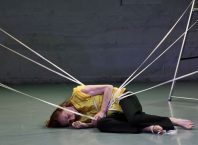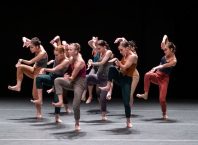Everyday life conspires to make us forget history in the exigency of the moment, the pull of the future. What is history, after all? It is by definition, past. Words in books we feel no urgency to open, stories we have heard so many times, their meaning is forgotten in repetition. Contemporary dance, constantly moving, changing, reinventing itself, is about as far away from history as anyone could run. Yet in Serenade/The Proposition, which premiered in Israel last night as part of the Israeli Opera – Tel Aviv Performing Arts Center (TAPAC) 09-10 Dance Series, choreographer Bill T. Jones meets history in a visually exciting, thought-provoking work that moves, in every possible sense of the word.
Created in honor of the Bicentennial of Abraham Lincoln’s birth, dance – with its sense of presence, ephemeral and fleeting, might appear an unlikely medium through which to relate to an historic figure, particularly one of such mythic stature as Lincoln. If nothing else, the abundance of information is daunting. It is impossible to consider Lincoln without also relating to slavery and the Civil War. How does one even begin to approach such a wide-ranging and weighty subject?
Jones has made some daring choices, which in combination with a talented creative team, and expressive, powerful dancers, create an unforgettable evening. Jones has a reputation for the unconventional, and Serenade/The Proposition, from beginning to end, is no exception. The evening began with a short documentary film on the background and process of creating the dance, and at the end of the performance, the internationally acclaimed choreographer came onstage with the members of his company, to talk to the audience “at eye level”, as they say in Hebrew.
Rather than viewing the distance from these events as an obstacle, Jones incorporates the sense of what he calls “my alienated generation” making that sense of distance and alienation – from history, from national identity – part of the work itself. In creating the dance, Jones said, “I didn’t want to tell a nice story about a great man who started poor, made a heroic gesture, and died a martyr.” Instead his focus was on “how to twist it, take it apart.”
Jones, in what is perhaps the greatest risk taken in this work, turned to the sources: documents, texts written by Lincoln and his contemporaries – such as Frederick Douglas and Julia Ward Howe, not only as part of his research process, but incorporated into the work itself. The text works in the same way as the choreography – non-illustrative, non-narrative, non-linear, and dynamic. Working on the level of sound and meaning at once, the words are touch-points, each phrase an entrance to the work through a different path. Some are historical texts, some are personal: Bill, as a young boy in the back seat of his parent’s car, Richmond Virginia, in the 1950s. History is not just a series of events in the past, it is our relationship to those events; it is us.
Taking the familiar and setting it in a different format and context, Jones creates an involvement with the subject that is personal and immediate. We may have some vague sense of Lincoln and the Civil War, we may have opinions about these topics, or we may be indifferent – but what takes place on the stage compels the eyes, mind and emotions. Both music and costumes reference the period, yet are not limited by it. Referencing songs familiar to American audiences – such as The Battle Hymn of the Republic and Dixie, and inspired by Mozart’s Requiem, the music takes us on a journey of its own, evocative, powerful, almost subversive. The music was composed and arranged by Jerome Begin, Lisa Komara and Christopher Antonio William Lancaster, whose live performance last night – in particular Komara’s singing, was inspirational.
The costumes, designed by Anjia Jalac and the Company, reflect past and present. The dancers appear first in casual, contemporary clothes, something they might reasonably wear in rehearsal – establishing the moment solidly in the present. When they reappear in costumes with period references – vests, skirts, petticoats, and jackets in black and white with glimpses and gashes of red, one remains aware that this is not the past, nor an attempt to recreate the past, but the present as it regards the past in relation to itself.
The video, created by Janet Wong, Associate Artistic Director of the company, reflects the artistic vision of the work, with its minimalist shades of black and white, and more significant – its reflective, interrogatory relationship to the material. Using photographs, graphics and movement, it is not merely a background to the choreography, but an individual presence in the work itself. Like the text, music and costumes, the images are broken up, changed, moved, and reinterpreted, engaging the viewer visually and artistically.
One could ignore all history and interpretation and enjoy the dance – in all its beauty, abstraction and expressive force. Yet, the sounds, silence, movement, stillness, images and empty space all work together to create a deeply resonant experience.
Midnight East message to readers: don’t miss the opportunity to see this amazing creative team! Message to the Bill T. Jones/Arnie Zane Dance Company: don’t wait another 14 years to come back to Israel!
Serenade/The Proposition will be performed again at TAPAC tonight, and this coming weekend as part of the Israel Festival. The Bill T. Jones/Arnie Zane Dance Company will also perform “Between Us” – a selection of works from the repertoire that made this company world famous, in Haifa.
Serenade/The Proposition
June 2 at 21:00 Israeli Opera House – Tel Aviv Performing Arts Center
19 Shaul Hamelech Boulevard, Tel Aviv, Tickets: 03-6927777
June 5 & 6 at 21:00, Sherover Hall, Jerusalem Theatre
20 David Marcus Street, Jeruesalem, Tickets: 1 – 700-70-20-15
Between Us
June 7 at the Haifa Auditorium
138 HaNassi Boulevard, Haifa, Tickets: 04-8353555
AYELET DEKEL






